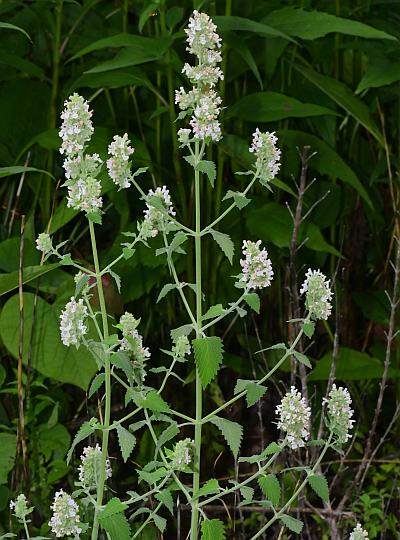Nepeta cataria L.
Catnip

Introduced
CC = *
CW = 3
MOC = 36
© SRTurner
Nepeta cataria L.Catnip | |
 |
Introduced CC = * CW = 3 MOC = 36 |
© SRTurner |
|
Family - Lamiaceae Habit - Taprooted perennial forb. Stems - Ascending to erect, to 1 m, bluntly to sharply 4-angled, branched, densely pubescent with felted or somewhat woolly, sometimes matted, short, white to grayish-tinged hairs.
Leaves - Opposite, decussate, simple, petiolate, with a characteristic odor when bruised or crushed. Petioles unwinged or winged only at the very tip. Leaf blades 2-8 cm long, ovate to ovate-triangular, unlobed, the margins mostly coarsely toothed, truncate to shallowly cordate at the base, angled to a bluntly or sharply pointed tip, the upper surface green and sparsely to moderately pubescent with short, curved hairs, the undersurface usually pale, densely pubescent with felted or somewhat woolly, sometimes somewhat matted, short, white to grayish-tinged hairs, also with conspicuous sessile glands, these sometimes obscured by the hairs.
Inflorescence - Terminal, short, dense, headlike clusters when young, usually elongating into dense, but often interrupted, spikelike racemes, these sometimes with short branches (then paniculate), the flowers numerous per node, some sessile, others short-stalked. Bracts 6-30 mm long, often absent from the upper inflorescence nodes, narrowly ovate to lanceolate, sharply pointed but not spinescent; bractlets inconspicuous, minute, mostly linear.
Flowers - Calyces 5-7 mm long at flowering, zygomorphic, usually slightly pouched on 1 side at the base, tubular, the tube strongly 15-nerved, densely pubescent with short, fine, mostly spreading hairs on the outer surface, also with relatively dense, sessile glands, densely hairy in the mouth, the lips shorter than the tube, the upper lip 3-lobed, longer than the 2-lobed lower lip, the lobes all similar, narrowly triangular, tapered to sharply pointed, but not spinescent tips, becoming papery at fruiting. Corollas 7-12 mm long, zygomorphic, 2-lipped, dull white to light cream-colored, the lower lip with pink to purple spots or mottling, the outer surface densely short-hairy, the tube funnelform, hairy in the throat, the lips shorter than to about as long as the tube, the upper lip shorter than the lower lip, entire or shallowly notched, slightly concave to more or less hooded, the lower lip spreading to arched, 3-lobed with a large central lobe and 2 small lateral lobes, the central lobe somewhat scoop-shaped, notched or more commonly with several small teeth at the broadly rounded to truncate tip. Stamens 4, short-exserted, the upper pair slightly longer than the lower pair, the anthers small, the connective short, the pollen sacs 2, spreading, purple. Ovary deeply lobed, the style appearing more or less basal from a deep apical notch. Style short-exserted, with 2 equal branches at the tip.
Fruits - Schizocarps, separating into usually 4 nutlets, these 1.3-2.0 mm long, mostly oblong-obovoid, rounded at the tip, the surface reddish brown to dark brown, smooth or with few to several faint, longitudinal lines or grooves, glabrous. Flowering - June - September. Habitat - Mesic upland forests, streambanks, and bases of bluffs, fields, pastures, fencerows, old homesites, railroads, roadsides, and disturbed areas. Also cultivated. Origin - Native to Europe. Lookalikes - Vegetatively similar to Fleischmannia incarnata. Other info. - This species is found in scattered locations in Missouri, less commonly in the southeastern quadrant of the state. It occurs to some extent in nearly every state in the continental U.S., most abundantly in the northern half of the country. Missouri occurrences often trace to former nearby cultivation. Although it does spread to wild areas, it is not particularly common across Missouri's landscapes. The plant is easily recognized by its oppositely arranged, toothed, triangular leaves and mint-pattern, two-lipped zygomorphic flowers. The lower lip usually has a distinctive ragged or toothed appearance. Photographs taken at the Kansas City Zoo, 6-22-99 and 6-30-00 (DETenaglia); also near Labadie, Franklin County, MO, 6-29-2020 (SRTurner). |